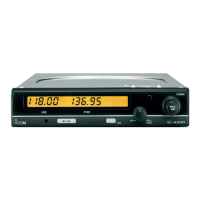
Do you have a question about the Icom IC-A200 and is the answer not in the manual?
| Brand | Icom |
|---|---|
| Model | IC-A200 |
| Category | Transceiver |
| Language | English |
Important safety and operating instructions for the IC-A200 transceiver.
Avoid extreme temperatures and ensure correct power supply to prevent damage.
Thanks for purchasing, highlights state-of-the-art technology and ease of operation.
Details tuning knobs, volume control, channel switch, and frequency exchange switch on the front panel.
Explains the USE window, STBY window, TX indicator, and memory indicators on the display.
Describes headphone jack, microphone jack, and yoke-mounted switches for remote control.
Covers general selection, direct selection, and using memory channels for quick access.
How to select frequencies in the STBY window using tuning knobs in 1 MHz or 25/50 kHz steps.
How to swap frequencies between the USE and STBY windows using the switch.
How to select frequencies directly in the USE window by hiding the STBY frequency.
A step-by-step guide to setting a specific frequency in the STBY window and transferring it to the USE window.
Steps for receiving signals, including squelch control and audio adjustment.
Steps for transmitting, including PTT operation, microphone usage, and interference prevention.
Information on blank channels, switch operations, and channel protection during programming.
Detailed steps for programming frequencies into the available memory channels.
A practical example demonstrating how to program a specific frequency into a memory channel.
How to recall programmed memory channels into the STBY window for quick access.
How to recall memory channels into the USE window, updating the STBY window simultaneously.
An example illustrating the process of recalling a memory channel into the STBY window.
How to select memory channels remotely using the yoke-mounted channel switch.
Instructions on how to safely remove the transceiver from its mounting rack.
Instructions on how to properly install the transceiver into its mounting rack.
Provides overall technical details including frequency range, power, dimensions, and weight.
Details the technical specifications for the transmitter section, such as output power.
Details the technical specifications for the receiver section, such as sensitivity and intermediate frequencies.